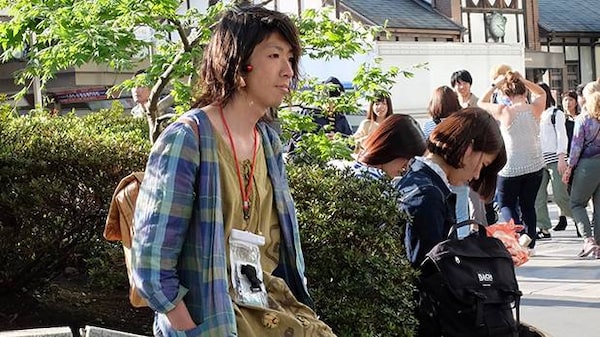
Brands such as Kuon are reinventing a traditionally utilitarian style for a modern aesthetic.
Talking about Japanese fashion is a bit like discussing American music: whether you're talking about about Billie Holiday or the Ramones or NWA it's still essentially the same conversation, and it can go on pretty much indefinitely. The same is true of conversations about kimonos, Rei Kawakubo and the wig-loving girls of Harajuku. Just as American music is the poetry of struggle and rebellion, Japanese fashion is the story of studied craftsmanship and boundless creativity. In both cases, if you like it, you really like it. While Japanese designers have bestowed futuristic drapey streetwear and perfect recreations of American denim on the world, they're increasingly looking to their own back catalogue for inspiration. Among their most popular rediscoveries is 'boro', the traditional craft of Japanese patchwork that's in the process of migrating from museum piece to fashion staple.
"Literally 'boro boro' means tattered or worn out," says Yumi Fukayama, whose brand Boro Note began as an online catalogue of her vintage patchworked jackets and has since grown into an outerwear and accessories brand. A recent collaboration with the denim brand Denham saw her crafting pouches and woven neckerchiefs from scraps of vintage fabric, but she also does a brisk business through a handful of American retailers and over Instagram. Boro began out of necessity in feudal northern Japan, Fukayama explains, where cotton was in short supply and farmers would patch their hemp and linen clothes with whatever bits of fabric they could find. It's an invention borne of the Japanese philosophy 'mottainai', which translates as "too good to waste." These were simple, utilitarian clothes – the opposite of fashion – but thanks to Japan's characteristic obsession with craft and refinement, they became objects of beauty all the same.
Fukayama isn't the only one in Japan to become captivated by the boro aesthetic. Indeed, her interest was initially inspired by Visvim, a Tokyo-based brand favoured by Pharrell Williams and John Mayer whose designs blend classic Americana with traditional Japanese craftsmanship. It was one of the first brands to embrace boro, and continues to integrate the style into its collections. Among Visvim's mainstay slouchy cardigans, wide t-shirts and dark denim jeans, it regularly releases limited-run, hand sewn boro pieces, recently including a kimono jacket stuffed with goose down and lined in a native American print. At Kapital's Tokyo store, which feels like the home of a very crafty, very stylish hermit, boro vests, jackets and trousers hang from the walls on mismatched hangers. Composed of the most spectacular network of stitched fabrics, these garments are so intricately assembled that it's impossible to tell where the base layer ends and the patches begin. Like Visvim's pieces, these are patched by hand, each one pieced together from scraps of blankets, bandanas and denim, each one unique.
It's ironic that in a country that reveres vintage dungarees and flannel shirts as much as this one, their own traditional workwear was not just unpopular but actively disregarded by many Japanese. "They didn't really pay attention to it or think it was a very precious thing, so they actually threw it out," says Fukayama, who was able to save a few of her own family's pieces before they ended up in the landfill. "This was worn by farmers, and is a symbol of poverty," she explains. "It's not a nice connotation because it means that you're from a poor family." Much like the 1950s Levis that used to be widely available in flea markets – and now sell for thousands of dollars to enthusiastic collectors – authentic boro is getting harder to find. As bigger name labels like Comme des Garçons and Junya Watanabe embrace the style, the influence of boro spreads wider still, appearing on stitched onto shirts, and printed onto sneakers and backpacks.
While Fukayama is enjoying the rising global appreciation of boro – and the attendant increase in sales – she's also wary of its commodification. Just as vintage workwear is imbued with the stories of the cowboys, bikers and gold miners who shaped American culture, boro speaks to a time, place and people who contributed to the identity of modern-day Japan. Cheap imitations and mass-market production, she says, could rob this piece of Japanese history of what makes it special. "I don't want something with a lot of Japanese culture behind it to become fast fashion and be forgotten," she says. "They are a part of someone's story and I want to keep them precious for this uniqueness that they have." Fukayama's concerns will be familiar to anyone who's heard a cherished song repurposed to sell cars or mobile phone plans – the things we love sometimes fall into the wrong hands. In the meantime, Fukayama continues scouring antiques shops and flea markets for scraps of fabric, painstakingly creating her patchworks for those who appreciate the artistry and ingenuity of Japanese design.
Visit tgam.ca/newsletters to sign up for the Globe Style e-newsletter, your weekly digital guide to the players and trends influencing fashion, design and entertaining, plus shopping tips and inspiration for living well. And follow Globe Style on Instagram @globestyle.